This article describes the main features of Nikon lenses and cameras, especially their compatibility with each other.
Navigation:
- Miscellaneous Mounts for Nikon Digital Cameras
- Nikon DX, Nikon FX, Nikon CX, IX-Nikkor
- Auto focus
- Iris control
- Focus distance transmission, D-type lenses
- Old Nikon autofocus lenses
- Example of 'reading' the lens name
- Comments
Miscellaneous Mounts for Nikon Digital Cameras
A bayonet is a method of attaching a lens to a camera.
Nikon digital cameras with interchangeable lenses are divided into three types, depending on the type of mount.
- digital Mirror Cameras (CZK) with a bayonet mount Nikon f
- digital Mirrorless Cameras (BZK) with a bayonet mount Nikon Z
- digital Mirrorless Cameras (BZK) with a bayonet mount Nikon 1
All lenses with Nikon F mount can be used on cameras with Nikon Z mount using a special adapter Nikon FTZ / Nikon FTZ II. Only Nikon lenses that have a built-in focus motor (marked in the lens name) are fully compatible with this adapter. AF-I, AF S, AF-P).
Nikon F mount 'AF' lenses (with autofocus support but no built-in focus motor) will not auto focus on cameras Nikon Z using adapter Nikon FTZ / Nikon FTZII.
List of all Nikon DSLR cameras with Nikon F mount
D1, D1h, D1x, D2x, D2h, D2xs, D2hs, D100, D200, D300, D300s, D500, D50, D70, D70s, D80, D90, D7000, D7100, D7200, D7500, D40, D40x, D60, D3000, D3100, D3200, D3300, D3400, D3500, D5000, D5100, D5200, D5300, D5500, D5600, D600, D610, D700, D750, D780, D800,D800E, D810, D810a, D850, D3, D3s, D3x, D4, D4s, D5, D6, Df+ Kodak DCS PRO 14n (and its modifications) and Kodak DCS Pro SLR / n (and its modifications) + Fujifilm FinePix S1 Pro, S2 Pro, S3 Pro, S3 Pro UVIR, S5 Pro, IS Pro.
List of all Nikon digital mirrorless cameras with Nikon Z mount
Full frame Nikon Z mount cameras
- Nikon z5 [July 2020, AliExpress]
- Nikon z6 [August 2018]
- Nikon z6 ii [October 2020, AliExpress]
- Nikon z7 [August 2018]
- Nikon z7 ii [October 2020, AliExpress]
- Nikon z8 [May 2023, AliExpress]
- Nikon z9 [October 2021, AliExpress]
- Nikon Zf [September 2023]
List of all 'Nikon Nikkor Z' full-frame lenses for mirrorless cameras with Nikon Z mount
Fixes:
- Nikon Nikkor Z 20 mm 1:1.8 S [February 2020, Aliexpress Nikon Store]
- Nikon Nikkor Z 24 mm 1:1.8 S [September 2019, AliExpress]
- Nikon Nikkor Z 26 mm 1:2.8 [January 2023]
- Nikon Nikkor Z 28 mm 1:2.8 [October 2021, AliExpress]
- Nikon Nikkor Z 28 mm 1:2.8 SE [June 2021]
- Nikon Nikkor Z 35 mm 1:1.8 S [August 2018, AliExpress]
- Nikon Nikkor Z 40 mm 1:2 [September 2021, AliExpress]
- Nikon Nikkor Z 40 mm 1:2 SE [November 2022]
- Nikon Nikkor Z 50 mm 1:1.2 S [September 2020]
- Nikon Nikkor Z 50 mm 1:1.8 S [August 2018, AliExpress]
- Nikon Nikkor Z 50 mm 1:2.8 MC [June 2021]
- Nikon Nikkor Z 58 mm 1:0.95 S Nod [October 2019]
- Nikon Nikkor Z 85 mm 1:1.2 S [January 2023]
- Nikon Nikkor Z 85 mm 1:1.8 S [July 2019, AliExpress]
- Nikon Nikkor Z 105 mm 1:2.8 S VR MC [June 2021]
- Nikon Nikkor Z 135 mm 1:1.8 S full [September 2023]
- Nikon Nikkor Z 400 mm 1:2.8 S VR TC [January 2022]
- Nikon Nikkor Z 400 mm 1:4.5 S VR [June 2022, AliExpress]
- Nikon Nikkor Z 600 mm 1:4 S VR TC [November 2022]
- Nikon Nikkor Z 600 mm 1:6.3 S VR PF [October 2023]
- Nikon Nikkor Z 800 mm 1:6.3 S VR PF [April 2022]
Zuma:
- Nikon Nikkor Z 14-24 mm 1:2.8 S [September 2020, Aliexpress Nikon Store]
- Nikon Nikkor Z 14-30 mm 1:4 S [January 2019, AliExpress]
- Nikon Nikkor Z 17-28 mm 1:2.8 [September 2022, AliExpress]
- Nikon Nikkor Z 24-50 mm 1: 4-6.3 [July 2020, AliExpress]
- Nikon Nikkor Z 24-70 mm 1:4 S [August 2018, AliExpress]
- Nikon Nikkor Z 24-70 mm 1:2.8 S [February 2019, AliExpress]
- Nikon Nikkor Z 24-120 mm 1:4 S [October 2021, AliExpress]
- Nikon Nikkor Z 24-200 mm 1: 4-6.3 VR [February 2020, AliExpress]
- Nikon Nikkor Z 28-75 mm 1:2.8 [December 2021, AliExpress]
- Nikon Nikkor Z 28-400 mm 1: 4-8 VR [March 2024]
- Nikon Nikkor Z 70-180 mm 1:2.8 [June 2023]
- Nikon Nikkor Z 70-200 mm 1:2.8 S VR [January 2020, AliExpress]
- Nikon Nikkor Z 100-400 mm 1: 4.5-5.6 S VR [October 2021]
- Nikon Nikkor Z 180-600 mm 1: 5.6-6.3 VR [June 2023]
Third party autofocus full-frame lenses for Nikon Z mount
- felttrox: 16/1.8, 20/2.8, 24/1.8, 28/1.8, 35/1.8, 40/2.5, 50/1.8, 85/1.8
- Tamron: 28-75/2.8G2, 35-150/2-2.8, 70-300/4.5-6.3, 150-500/5-6.7
- yongnuo: 35/2, 50/1.8, 85/1.8
- Meike: 50/1.8, 85/1.8, 85/1.4
- TTArtisan: 32/2.8
- 7Artisans: 50/1.8
- AstrHori: 85/1.8
- laowa: 10/2.8
All of these lenses have a Nikon STM (Stepping Motor) built-in focusing motor, similar to lenses. Nikon AF-P. As well as an electromagnetic diaphragm similar to lenses Nikon E.
The letter 'S' in the name of these lenses only denotes their belonging to the line of professional mirrorless solutions.
The exact list of system mirrorless cameras with interchangeable lenses Nikon 1:
Nikon has released a series of mirrorless cameras with interchangeable lenses and Nikon 1 mount and 1 Nikkor lenses (they are also called Nikon CX).
- Nikon 1 J1, Nikon 1 J2, Nikon 1 J3, Nikon 1 J4, Nikon 1 J5.
- Nikon 1S1, Nikon 1S2
- Nikon 1 V1, Nikon 1 V2, Nikon 1 V3
- Nikon 1AW1
On these cameras, it is best to use specially designed Nikon CX lenses (the same as 1 Nikkor).
An exact list of all Nikkor 1 lenses:
Fix Lenses:
- Nikon 1 NIKKOR 10mm f / 2.8 (black and silver)
- Nikon 1 NIKKOR AW 10mm f / 2.8 (only black)
- Nikon 1 NIKKOR 18.5mm f / 1.8 (black, silver, white)
- Nikon 1 NIKKOR 32mm f / 1.2 (black, silver)
Zoom lenses
- Nikon 1 NIKKOR VR 6.7-13mm f / 3.5-5.6 (black and silver)
- Nikon 1 NIKKOR VR 10-30mm f / 3.5-5.6 (8 color options)
- Nikon 1 NIKKOR VR 10-30mm f / 3.5-5.6 PD-ZOOM (6 color options)
- Nikon 1 NIKKOR VR 10-100mm f / 4-5.6 (5 color options)
- Nikon 1 NIKKOR VR 10-100mm f / 4.5-5.6 PD-ZOOM (only black)
- Nikon 1 NIKKOR 11-27.5mm f / 3.5-5.6 (6 color options)
- Nikon 1 NIKKOR AW 11-27.5mm f / 3.5-5.6 (black, silver, white)
- Nikon 1 NIKKOR VR 30-110mm f / 3.8-5.6 (8 color options)
- Nikon 1 NIKKOR VR 70-300mm f / 4.5-5.6 N (only black)
- AW (All Weather) are weatherproof lenses. These lenses are best suited for a rugged camera Nikon 1 AW1.
- PD Zoom (Power Drive Zoom) - auto zoom lenses. With these lenses, the focal length can be changed automatically instead of manually rotating the zoom ring. To do this, these lenses have a slider TW (Tele - Wide, for zooming in tele [Tele] range or wide-angle [Wide] range).
To install FX or DX lenses on Nikon 1 series cameras you need to use FT1 adapter at the same time, automatic focusing is retained only with AF-S lenses (possibly AF-P) and only with certain lenses specified in this the table.
UPD: In the summer of 2018, the Nikon 1 system stopped its development.
Nikon FX and Nikon DX digital cameras and lenses, their difference
Nikon digital and mirrorless cameras are divided into two types, depending on the size of the sensor: FX and DX. Lenses for these cameras are also marked in the same way.
FX lenses are designed for full-format FX cameras (also called full-frame, or full-size, or full-frame).
DX lenses are designed for cropped DX cameras (they are also called crop, or cameras with APS-C sensor size).
Nikon FX cameras have a matrix the size of a classic 35 mm film, DX cameras have a smaller matrix, the so-called 'cropped', with a frame diagonal 1.5 times smaller than in FX.
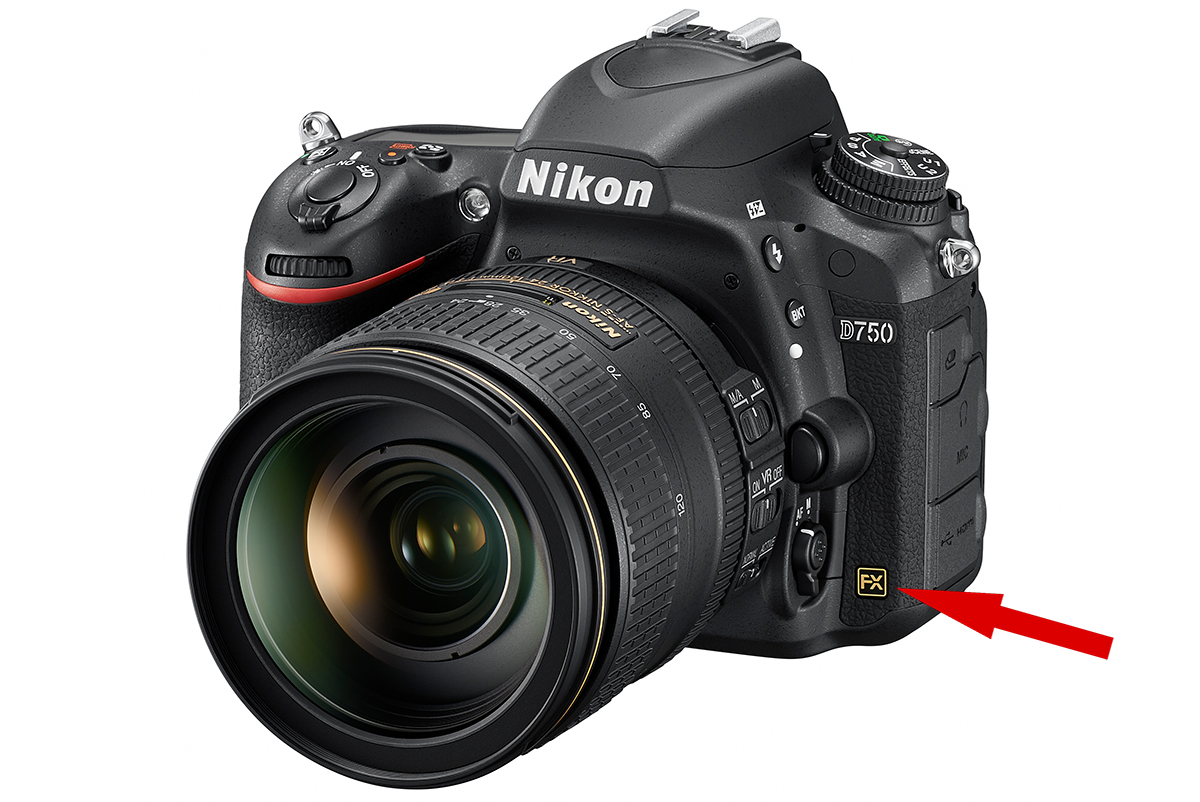
Full-format camera Nikon D750 has the 'FX' mark on its body. He is shown here with a full-frame lens. Nikon N AF-S Nikkor 24-120mm 1: 4G ED VR SWM IF Aspherical Nano Crystal Coat
Before the Nikon DX cameras, there were only full-frame Nikon FX cameras and lenses that don't really have the FX designation, since at that time it was not necessary to separate the full frame and the cropped one. Examples of lenses from full-frame cameras:
- Nikon AF-S Nikkor 85mm 1: 1.8G SWM IF SWM
- NIKON ED AF-S NIKKOR 28-300mm 1: 3.5-5.6G SWM VR IF Aspherical
- Nikon ED AF Nikkor 80-200mm 1: 2.8D
As you can see, the prefix 'FX' is not indicated in the lens name. If the lens is not labeled DX or CX, then it is a full frame lens for an FX camera.
After the advent of digital SLR cameras, Nikon DX, the manufacturer, to save on glass, metal and plastic, began the production of DX lenses. And all lenses for cropped cameras already had the DX designation. Examples of DX lenses:
- Nikon DX AF-S Nikkor 35mm 1: 1.8G SWM Aspherical
- Nikon DX 18-55mm 1: 3.5-5.6GII VR II AF-S Nikkor
- Nikon DX AF-S Micro Nikkor 40mm 1: 2.8G SWM
As you can see, all lenses have the letters DX in the name.
Important about DX and FX
Exact list of all Nikon DX cameras:
D1, D1h, D1x, D2x, D2h, D2xs, D2hs, D100, D200, D300, D300s, D500, D70, D70s, D80, D90, D7000, D7100, D7200, D7500, D40, D40x, D60, D3000, D3100, D3200, D3300, D3400, D3500, D5000, D5100, D5200, D5300, D5500, D5600
+ Fujifilm FinePix S1 Pro, S2 Pro, S3 Pro, S3 Pro UVIR, S5 Pro, IS Pro.
It is very important, so important that everyone should know this: All Nikon DX series cameras have the same real physical size of their sensor (matrix). The size is approximately 23.6 mm X 15.8 mm. Physical size is not directly related to the number of MegaPixels.
Exact listing of all Nikon FX cameras
Nikon F: D600, D610, D700, D750, D780, D800,D800E, D810, D810a, D850, D3, D3s, D3x, D4, D4s, D5, D6,Df
+ Kodak DCS PRO 14n (and its modifications) and Kodak DCS Pro SLR / n (and its modifications)
It is very important, so important that everyone should know this: all cameras of the Nikon FX series have the same real physical size of their sensor (matrix). The size is approximately 36 mm X 24 mm. Physical size is not directly related to the number of MegaPixels.
Recommended use:
- All Nikon DX lenses can and should preferably be used on Nikon DX series sprinkler cameras (the exact list is listed above).
- All Nikon DX lenses can be used on full-frame cameras such as Nikon D3, D3s, D3x, D4, D4s, D5, D6, Df, D600, D610, D700, D750, D780, D800,D800E, D810, D810a, D850 but the camera will either use only part of its sensor to take a photo, or the resulting image will have irreparable vignetting and other distortions at the edges and corners of the frame. This is due to the fact that DX lenses cannot project an image onto the large matrix of FX cameras. Using DX lenses on FX cameras is not recommended.... Full-frame cameras can automatically recognize and adjust the DX lens to work with it. Personally, I see no reason to buy an expensive full frame DSLR camera and use more 'simple' DX lenses on it.
- For all Nikon FX cameras, it is recommended that you use only Nikon FX lenses.
- All full-frame lenses (lenses from FX cameras) can be used on DX cameras without any problems, and you only need to consider the visual effect of crop factor.
As an example, a full-frame shot Nikon D700 FX (Full frame) and cropped lens Nikon DX AF-S Nikkor 35mm 1: 1.8G SWM Aspherical. The camera is set to full-frame mode 'image area FX'. It can be seen that the cropped lens gives black corners (vignette) and the picture is not usable.
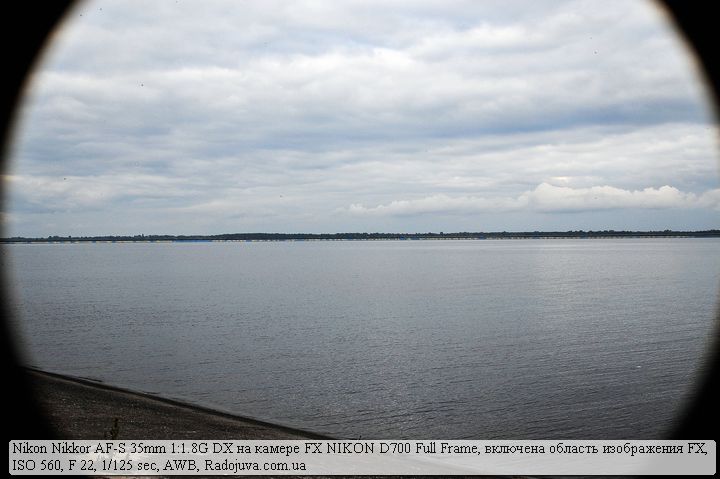
Black angled shot
If you take the same photo, but in the camera mode '' image area DX', then the camera will automatically use only the central area of its sensor and as a result the image will be like any other Nikon DX camera. Below is the same shot on Nikon D700 FX (Full Frame) in 'modeDX image area'.
Indeed, Nikon FX full-frame cameras can use cropped lenses in 'DX' crop mode. In this mode, only the central part of the camera sensor will be used, equal in size to the sensor used in Nikon DX cameras, which will avoid vignetting using a cropped lens on full-frame cameras. To do this, in the camera menu, just turn on the 'Image area' -> 'Select. image area 'and select the' DX format 24x16 'value there.
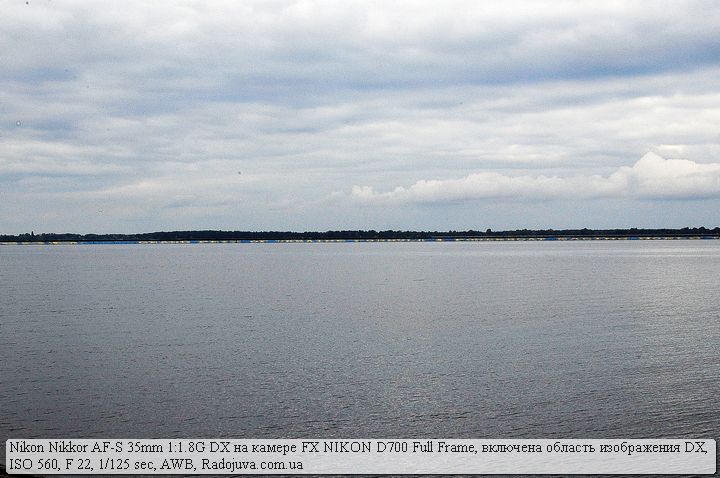
Full frame in DX mode
If you summarize the above points, then it begs small conclusion - Conventional FX lenses can be used on all types of cameras: FX and DX. And lenses from cropped DX cameras are not recommended for use on full-frame FX cameras.
An accurate list of all Nikon DX Nikkor lenses
Fixes
- Nikon DX AF Fisheye Nikkor 10.5 mm 1: 2.8G ED with a golden ring (review here)
- Nikon DX AF-S Nikkor 35 mm 1: 1.8G SWM Aspherical (review here)
- Nikon DXAF-S Microphone Nikkor 40 mm 1: 2.8G SWM (review here)
- Nikon DXAF-S Microphone Nikkor 85 mm 1: 3.5G ED VR SWM IF Micro 1: 1 (review here)
Wide angle
- Nikon DX AF-P Nikkor 10-20 mm 1: 4.5-5.6G VR (price is here)
- Nikon DX AF-S Nikkor 10-24 mm 1: 3.5-4.5G ED SWM IF Aspherical (review here)
- Nikon DX AF-S Nikkor 12-24 mm 1:4G ED SWM IF Aspherical with a golden ring (review here)
Universal
- Nikon DX AF-S Nikkor 16-80 mm 1: 2.8-4E N ED VR Nano crystal coat SWM IF Aspherical with a golden ring (price here)
- Nikon DX AF-S Nikkor 16-85 mm 1: 3.5-5.6G ED SWM VR IF Aspherical(review here)
- Nikon DX AF-S Nikkor 17-55 mm 1:2.8G ED SWM IF Aspherical with a golden ring (review here)
- Nikon DX AF-S Nikkor 18-55 mm 1: 3.5-5.6G ED SWM Aspherical [Black / Silver] (review here)
- Nikon DX AF-S Nikkor 18-55 mm 1: 3.5-5.6GII ED SWM Aspherical [black / silver] (review here)
- Nikon DX AF-S Nikkor 18-55 mm 1: 3.5-5.6G SWM VR aspherical (review here)
- Nikon DX AF-S Nikkor 18-55 mm 1: 3.5-5.6GII VRII (review here)
- Nikon DX AF-P Nikkor 18-55 mm 1:3.5-5.6G (price here)
- Nikon DX AF-P Nikkor 18-55 mm 1: 3.5-5.6G VR (review here)
- Nikon DX AF-S Nikkor 18-70 mm 1: 3.5-4.5G ED SWM IF Aspherical (review here)
- Nikon DX AF-S Nikkor 18-105 mm 1: 3.5-5.6G ED SWM VR IF Aspherical [Thailand / China] (review here)
- Nikon DX AF-S Nikkor 18-135 mm 1: 3.5-5.6G ED SWM IF Aspherical (review here)
- Nikon DX AF-S Nikkor 18-140 mm 1: 3.5-5.6G ED SWM VR IF Aspherical [Thailand / China] (review here)
- Nikon DX AF-S Nikkor 18-200 mm 1: 3.5-5.6G ED SWM VR IF Aspherical [Japan / China] (review here)
- Nikon DX AF-S Nikkor 18-200 mm 1: 3.5-5.6GII ED SWM VR IF Aspherical(review here)
- Nikon DX AF-S Nikkor 18-300 mm 1: 3.5-5.6G ED SWM VR IF Aspherical (price here)
- Nikon DX AF-S Nikkor 18-300 mm 1: 3.5-6.3GED SWM VR IF Aspherical(review here)
Televisions
- Nikon DX AF-S Nikkor 55-200 mm 1: 4-5.6G ED SWM [Black / Silver, Japan / China] (review here)
- Nikon DX AF-S Nikkor 55-200 mm 1: 4-5.6G ED VR IF SWM(review here)
- Nikon DX AF-S Nikkor 55-200 mm 1: 4-5.6GII ED VRII (review here)
- Nikon DX AF-S Nikkor 55-300 mm 1: 4.5-5.6G ED VR SWM HRI (review here)
- Nikon DX AF-P Nikkor 70-300 mm 1: 4.5-6.3G ED (price here)
- Nikon DX AF-P Nikkor 70-300 mm 1: 4.5-6.3G ed VR (price here)
All Nikon DX lenses for mirrorless cameras with Nikon Z mount and APS-C sensor
- Nikon Nikkor ZDX 24 mm 1:1.7 [May 2023]
- Nikon Nikkor ZDX 12-28 mm 1:3.5-5.6PZ VR [April 2023]
- Nikon Nikkor ZDX 16-50 mm 1:3.5-6.3VR [October 2019]
- Nikon Nikkor ZDX 18-140 mm 1:3.5-6.3VR [October 2021]
- Nikon Nikkor ZDX 50-250 mm 1:4.5-6.3VR [October 2019]
For Nikon Z DX (APS-C), there are third-party autofocus lenses:
- felttrox: 13/1.4, 23/1.4, 27 /1.2, 33/1.4, 56/1.4, 56/1.7, 75 /1.2
- Sigma: 16/1.4, 30/1.4, 56/1.4
- TTArtisan: 27/2.8, 35/1.8, 56/1.8
- yongnuo: 11/1.8, 33/1.4, 50/1.8
- Brightin Star 50 / 1.4
- Meike 55 / 1.4
Cameras Nikon Z DX (APS-C)
- Nikon z50 [October 2019, AliExpress]
- Nikon Z fc [June 2021, black/silver, AliExpress]
- Nikon z30 [June 2022, AliExpress]
Nikon DX Professional SLR Lenses
I didn't call Nikon DX lenses more 'simple' for a reason. It just so happened that all Nikon professional optics are lenses for the full frame. The only professional lenses for Nikon DX cameras are:
- Nikon DX AF Fisheye Nikkor 10.5mm 1: 2.8G ED
- Nikon DX AF-S Nikkor 17-55mm 1: 2.8G ED IF SWM Aspherical
- Nikon DX AF-S Nikkor 12-24mm 1: 4G ED SWM IF Aspherical
- Nikon DX AF-S Nikkor 16-80mm 1: 2.8-4E N ED VR Nano Crystal Coat SWM IF Aspherical
These lenses have gold ring near the front lens - a sign of top class lenses. These lenses are listed on Nikon NPS (Nikon Professional Services).
Attention: Nikon Nikkor DX lenses have non-equivalent focal lengths (EGF), but the physical real focal length of the lens. Focal length is a physical parameter of the lens itself, which does not change when installed on different cameras. And for FX and DX lenses, to find out EGF when used on cropped DX cameras, you need to multiply the focal length by crop factor Kf=1.5X. For example, EGF lens Nikon 18-55mm 1: 3.5-5.6GII VR II AF-S DX Nikkor on the cropped camera Nikon D7100 will be 27-82,5mm (18 * 1.5 and 55 * 1.5). The relationship of focal length and viewing angle can be viewed here.
Useful: if you select “Off” in the menu of full-size cameras in the “AF point illumination” setting, then after turning on one of the cropping modes (in fact - cropping), an unused area of the image visible in JVI, will be darkened, which greatly facilitates sighting using crop mode. The following shows how unused areas are obscured. JVI when you turn on certain crop modes.
About Auto Focus
For the ability to automatically focus the lens on the Nikon Nikkor lens designations AF, AF-I, AF-S and AF-P.
What is the difference between AF-S / AF-P / AF-I and AF lenses? In the AF lens, focusing is due to the motor of the camera, in such cases it is said that the camera has a 'screwdriver' or focusing motor. In contrast, in AF-S / AF-I / AF-P lenses, focusing is due to a motor directly integrated into the lens itself.
Lenses designated 'AF'
Such lenses do not have a built-in autofocus motor and will automatically focus only on cameras in which there is a focusing motor ('screwdriver').
Defining such a lens is very simple - it only has the 'AF' prefix in its name. Also, these lenses have a special groove on the bayonet side, through which the torque of the 'screwdriver' is transmitted. What is at stake can be seen in the photos below:
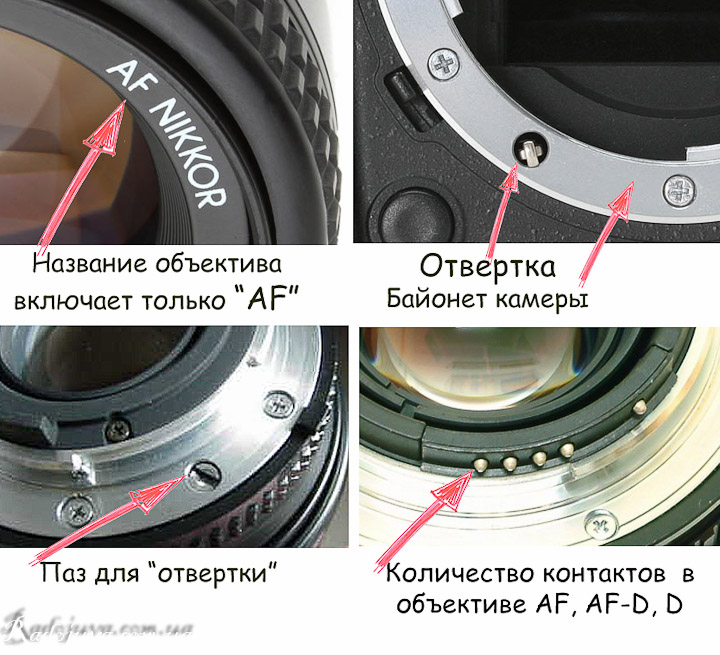
AF Lens - Highlights
An exact list of Nikon DSLR cameras with a built-in focus motor:
D50, D70, D70s, D80, D90, D100, D200, D300, D300s, D500, D7000, D7100, D7200, D7500, D600, D610, D700, D750, D780, D800,D800E, D810, D810a, D850, D1, D1h, D1x, D2x, D2xs, D2h, D2hs, D3, D3x, D3s, D4, D4s, D5, D6,Df
+ Fujifilm FinePix S1 Pro, S2 Pro, S3 Pro, S3 Pro UVIR, S5 Pro, IS Pro, Kodak DCS PRO 14n (and its modifications) and Kodak DCS Pro SLR / n (and its modifications)
An example of an 'AF' type lens - Nikon AF Nikkor 70-300mm 1: 4-5.6G. In turn, this lens will not be able to automatically focus on cameras that do not have a focus motor.
Cameras that do not have a built-in focus motor require the use of AF-S / AF-I / AF-P lenses.
Exact list of Nikon digital cameras without built-in focus motor:
D40, D40x, D60, D3000, D3100, D3200, D3300, D3400, D3500, D5000, D5100, D5200, D5300, D5500, D5600
+ Nikon ZFX, Nikon ZDX using adapter Nikon FTZ / Nikon FTZII
With these cameras, only auto focus and sound confirmation of focus will not work, all other important functions, such as auto metering exposure and auto iris control will work well.
Lenses designated 'AF-S'
For such lenses, the focus motor is already integrated directly into the lens barrel. These lenses will automatically focus on all Nikon cameras. These lenses include Nikon AF-S Nikkor 50mm 1: 1.8G SWM Aspherical.
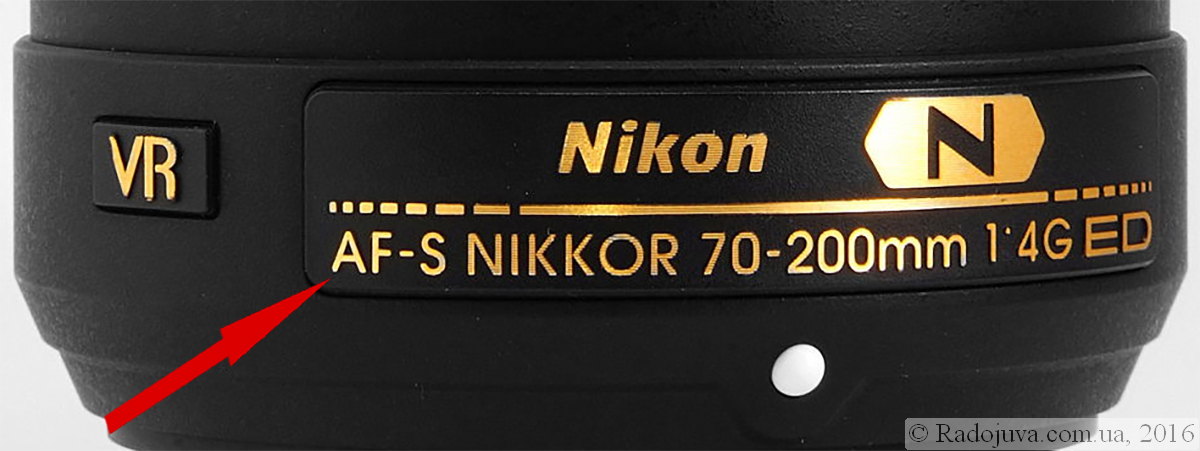
'AF-S' on the main lens name, which is usually written in gold letters. The photo shows Nikon N AF-S Nikkor 70-200mm 1: 4G ED SWM VR IF Nano Crystal Coat
Almost always on AF-S lenses, you can also find the prefix 'SWM', which stands for Silent Wave Motor (silent wave / ultrasonic motor).
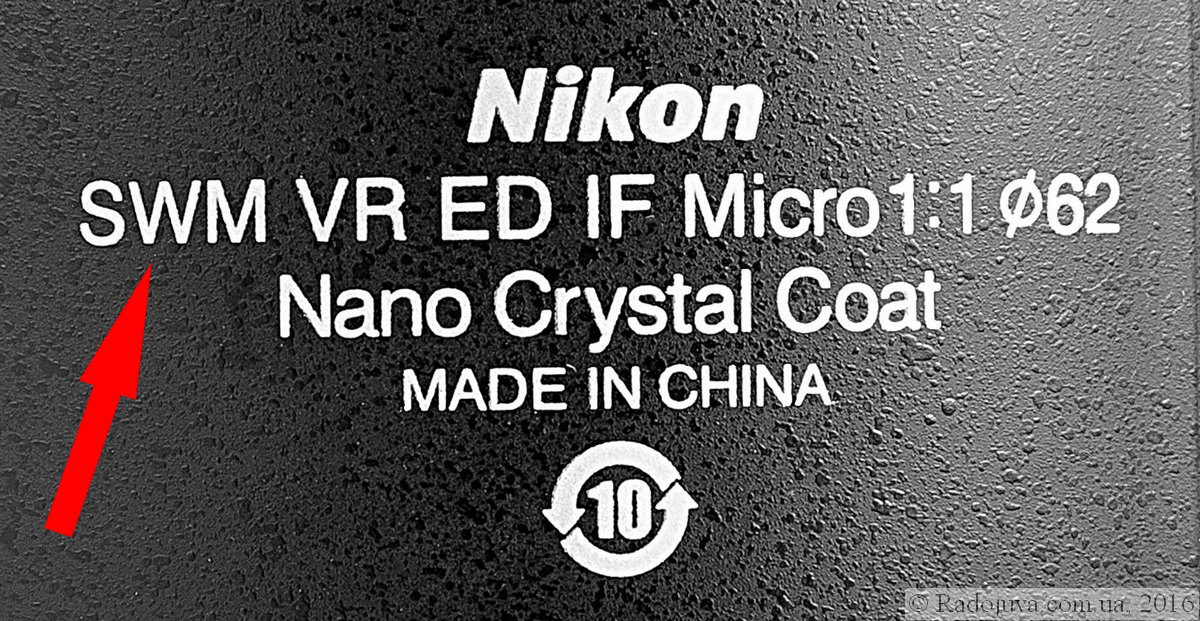
'SWM' stamped on the lens information plate Nikon N AF-S Micro Nikkor 105mm 1: 2.8G ED VR SWM IF Micro 1: 1 Nano Crystal Coat
Important: SWM motors come in two main types, details here.
If you use optics from other manufacturers, you need to know for sure whether the lens has a built-in motor or not, the designations of each manufacturer have their own and do not intersect with the designations of Nikon Nikkor lenses.
It is often said that on junior cameras from the Nikon line (their list is just above) you cannot use 'serious optics', but in fact this is a delusion. The point is only that autofocusing with certain lenses (and all functions associated with focusing) will not work with these cameras. When focusing manually, confirmation of successful focusing will be green circle in the viewfinder, and Live View and electronic range finder nobody canceled.
Attention: Nikon’s new non-motorized cameras still lose the ability to automatically control distortion (distortion, vignetting) when working with non-motorized lenses. All other functions will work just as well as with optics that have a focus motor.
If you install an AF-S, AF-P or AF-I lens on a camera with a built-in focus motor, which also has a built-in focus motor, then this is not a big deal. In this case, the built-in motor of the camera simply turns off automatically, and focusing is always performed only with the lens motor. There will never be any conflicts in the work between the camera and the lens.
Interesting: when using AF lenses, different cameras may have different focusing speeds. This issue has been considered in detail. here.
Important: due to certain features related with no EE lever for reading the extreme position of the diaphragm ringon cameras Nikon D3400, D3500 The following 'AF-S D' type lenses will not work properly (this only applies to these cameras):
- Nikon ED AF S Nikkor 17-35mm 1: 2.8D SWM IF Aspherical
- Nikon ED AF S Nikkor 28-70mm 1: 2.8D SWM
- Nikon ED AF S Nikkor 80-200mm 1: 2.8D Silent wave motor
- Nikon ED AF S Nikkor 300mm 1: 4D
- Nikon ED AF S Nikkor 300mm 1: 2.8D
- Nikon ED AF S Nikkor 300mm 1: 2.8D II
- Nikon ED AF S Nikkor 400mm 1: 2.8D [black / silver]
- Nikon ED AF S Nikkor 400mm 1: 2.8D II
- Nikon ED AF S Nikkor 500mm 1: 4D
- Nikon ED AF S Nikkor 500mm 1: 4D II
- Nikon ED AF S Nikkor 600mm 1: 4D
- Nikon ED AF S Nikkor 600mm 1: 4D II
- as well as all lenses AF-I
Lenses designated 'AF-P'
Nikon introduced Nikon Nikkor 'AF-P' lenses in January 2016. Designation 'AF-P' (Auto Fear Pulse motor) indicates the presence of a fast and Nikon STM (Stepping Motor) focusing motor. 'AF-P' lenses work similarly to 'AF-S', only quieter, faster and more accurate. The same type of motor is used for lenses for mirrorless cameras Nikon Z.
Please note that not all Nikon cameras will be able to work correctly with 'AF-P' lenses, some cameras will need to be updated to be fully 'AF-P' compatible.
Full list of Nikon 'AF-P' lenses:
- Nikon DX AF-P Nikkor 10-20 mm 1: 4.5-5.6G VR
- Nikon DX AF-P Nikkor 18-55 mm 1: 3.5-5.6G
- Nikon DX AF-P Nikkor 18-55 mm 1: 3.5-5.6G VR
- Nikon DX AF-P Nikkor 70-300 mm 1: 4.5-6.3G ED
- Nikon DX AF-P Nikkor 70-300 mm 1: 4.5-6.3G ED VR
- Nikon AF-P Nikkor 70-300 mm 1: 4.5-5.6E VR ED
Auto focus with AF-P lenses will only work with cameras (exact list):
D5200, D5300, D5500, D5600, D3300, D3400, D3500, D7100, D7200, D7500, D500 + D4, D4s, D5, D6, Df, D800, D800E, D810, D810a, D850, D750, D780, D600, D610 + Nikon z6, Nikon z6 ii, Nikon z7, Nikon z7 ii, Nikon z5, Nikon z50 with adapter FTZ
Important: some of these cameras will need to use the latest firmware.
Auto and manual focus will not work with cameras (exact list):
D700, D3, D3s, D3x, D1, D1h, D1x, D2x, D2h, D2xs, D2hs, D100, D200, D300, D300s, D50, D70, D70s, D80, D90, D7000, D40, D40x, D60, D3000, D3100, D3200, D5000, D5100 + Fujifilm FinePix S1 Pro, S2 Pro, S3 Pro, S3 Pro UVIR, S5 Pro, IS Pro + Kodak DCS PRO 14n и Kodak DCS Pro SLR / n.
Lenses designated 'AF-I'
Side are the Nikon AF-I lenses. Motor lenses per se 'AF-I' (Auto Focus Internal Motor) - very rare lenses, and also very expensive. Some users mistakenly refer to them as 'AF-1' ('AF-one').
Some of these lenses use a built-in focusing motor for focusing, built on the basis of conventional electric micro-motors, which are pretty noisy during focusing. There is no exact data on what type of motor is used in Nikon AF-I lenses.
Attention: there is no exact information whether amateur-level cameras will work with such lenses. But, most likely, no mortal will ever mount such a lens on a simple amateur camera.
Full list of Nikon AF-I lenses:
- Nikon ED AF-I Nikkor 300mm 1: 2.8D, 1992-1996
- Nikon ED AF-I Nikkor 400mm 1: 2.8D, 1994-1998
- Nikon ED AF-I Nikkor 500mm 1: 4D, 1994-1997
- Nikon ED AF-I Nikkor 600mm 1: 4D, 1992-1996
When choosing a lens, the most important parameters are its type (FX, DX) and the focusing method. If you now know which FX or DX camera you have, with or without a built-in focus motor, then selecting the lens with just these two parameters will give you all the necessary functions for shooting.
Typically, lenses without a built-in focusing motor are cheaper than their motorized counterparts. If you have a camera with a motor, then in a sense you can save on lenses. As an example, you can look at Nikon 50mm 1: 1.8D AF Nikkor (MKIII)which is very cheap:
A version with a focus motor Nikon AF-S 50mm F / 1.8G costs a lot more.
Focus mode switch 'M / A-M' and 'A-M' or lack thereof
Nikon lenses usually have a focus mode switch. The 'A-M' (or 'M-A') switch means the lens can be set to either auto focus mode 'A' (Auto) or only manual focus mode 'M' (Manual). Switch 'M / A-M' indicates that the lens can work in the mode 'M / A' - automatic mode with manual focus correction at any time... 'M' mode allows manual focus control only.
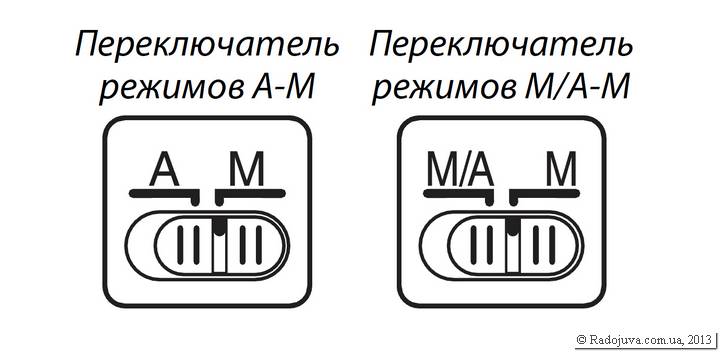
Two types of lens focus mode switch. Photos from the instructions for the camera Nikon D3200
'M / A' This mode is useful in that you do not need to move the lens to the 'M' position for manual focusing. When you start focusing manually in 'M / A' mode, auto focus switches off instantly, and the lens 'obeys' only the photographer. 'M / A' works with any available focusing method on the camera itself. If you release the focusing ring, the lens will immediately switch to automatic focusing mode. Also, with its help, you can easily use focus trap effect. If there is no focus mode switch, such as on the lens Nikon 50mm f / 1.8D AF Nikkor, then the focus mode should be selected on the camera itself.
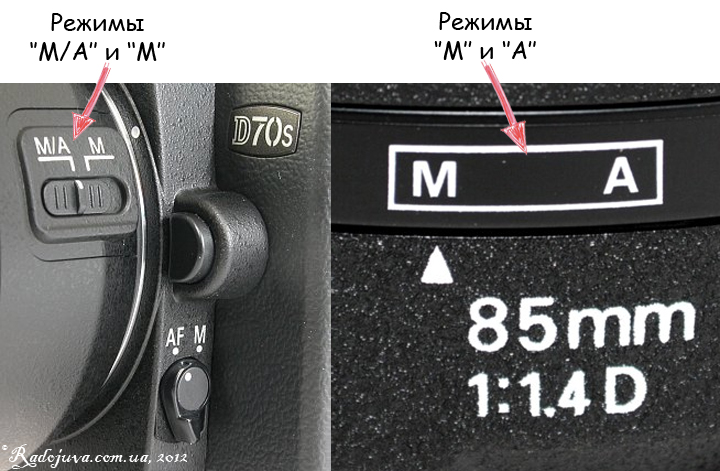
Focus mode switch - two views. Also, under the lens mount button, you can see a lever on the camera that performs AF M focus switches for lenses that do not have a switch.
Some Nikon lenses have additional specific modes 'A / m'and'Memory Recall', read about which you can here... And there are also features of the 'A' focus mode for some Nikkor AF-S lenses with an 'A-M' switch, which you can read about here.
About Iris Control Features
On Nikon lenses you can meet another interesting designation - letter 'G' - a lens with such a letter can control the diaphragm only directly from the camera, but the lens does not have an aperture control ring.
G ('Gelded') lenses are virtually impossible to use with some older film cameras as the aperture will be permanently closed there. Also, lenses with an aperture control ring (Non-G) can be used more flexibly for all kinds of photography surveys, such as reverse macro shot.
Mythology: It is often said that there are 'D' and 'G' lenses, D with an aperture control ring and G without an iris control ring. In fact it's a delusion - the letter 'D' (or 'AF-D') indicates the possibility of transferring the focusing distance to the subject to the camera - this makes it easier to calculate the flash power for the correct exposure... The misconception stems from the fact that almost all 'D' lenses have an aperture ring, since they did not previously denote a division into lenses with an aperture ring and without an aperture ring.
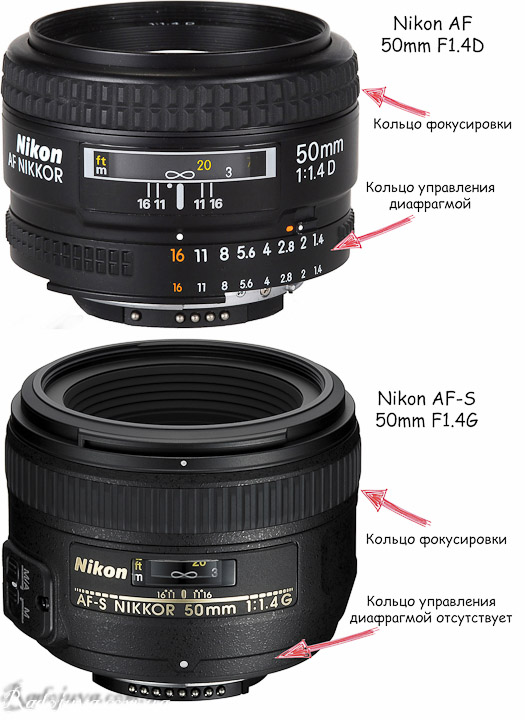
The difference of the lens G and without G (for example, lenses Nikon AF Nikkor 50mm 1: 1.4D и Nikon AF-S Nikkor 50mm 1: 1.4G SWM)
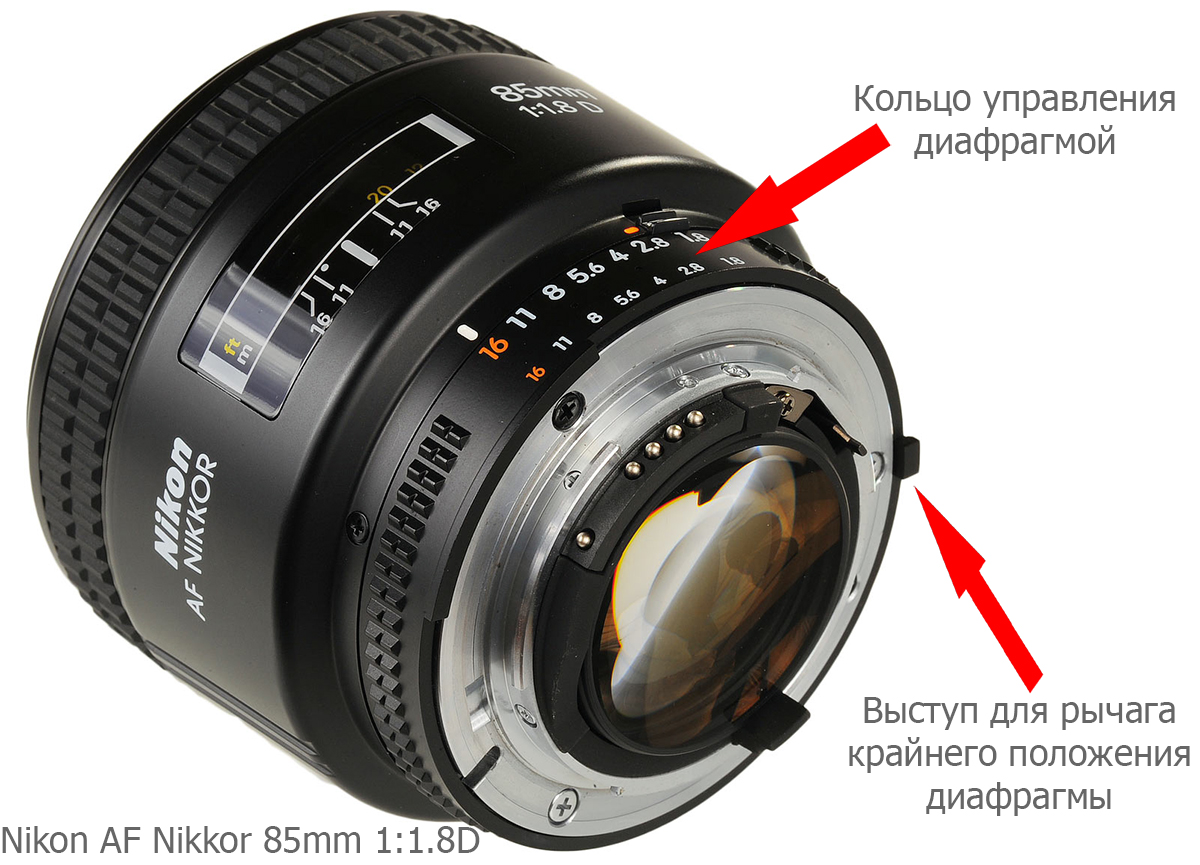
Lug for reading the extreme position of the aperture ring on the lens Nikon AF Nikkor 85mm 1: 1.8Dwhich is a NON-G type lens, that is, one that has an aperture control ring.
Very important: To use a 'NON-G' type lens (with aperture ring) in the same way as a G type lens (control aperture from the camera), you need to set the aperture control ring to the maximum F-number, usually F16, F22, F32 and switch the special lock on the lens, which will fix the iris control ring in a fixed position. Different lenses either lock the ring themselves in the extreme position, or require manual locking using a special switch. If this is not done, some cameras will display an 'fEE' error (aperture ring not set).
Some cameras allow you to control the iris with autofocus NON-G lenses in metering modes exposure A (aperture priority) and M (manual) with the aperture ring. To do this, in the camera menu, find the item 'Configure command dials' -> 'Set aperture' and set the value 'Aperture ring'. In S modes (priority excerpts) and P (program mode), the display will still show an 'fEE' error (no aperture ring set). When using autofocus lenses, I recommend using the 'Set Command Dials' -> 'Set Aperture' -> 'Sub Command Dial' function.
In addition, Nikon has released several lenses'E'-type, which also do not have a diaphragm control ring, and the diaphragm itself is closed by an electromagnetic drive located inside the lens. More details in the section 'Nikon E'.
Important: Nikon D3400, D3500 the only cameras that do not support auto iris control with Non-G lenses (which have an iris control ring). With these lenses Nikon D3400, D3500 cameras only work in 'M' mode (in fact, with all lenses that have an aperture control ring, cameras Nikon D3400, D3500 will not work).
The difference between D lenses and just AF lenses without the letter D (Non-D)
The letter “D” in the lens name indicates that the camera receives information from the lens about the distance at which the lens was focused.

The difference in AF D and just AF lenses
It's important: All 'G' and 'E' type lenses also transmit to the camera a value about the focusing distance to the subject and are simultaneously 'D' lenses.
Remember once and for all: the letter 'D' has nothing to do with the aperture ring. It just so happens that most lenses with an aperture control ring are capable of transmitting focusing distance and are marked with the letter 'D'. Usually lenses are marked at the same time 0 'G' and 'AF-S', or simultaneously 'AF 'and' D 'but there are many exceptions, for example Nikon ED AF Nikkor 28-200mm 1:3.5-5.6G IF Aspherical - an instance that does not have a diaphragm control ring (G), but at the same time has an old AF screwdriver focus. Also, for example, there is Nikon 28-70mm 1: 2.8D ED AF S Nikkor - which has a built-in focusing motor (AF-S) and aperture control ring (NON-G), while transmitting the focusing distance (D).
Differences when using AF lenses with the letter D and AF without “D” when the flash is off, you will not notice, since it is practically absent. But it’s worth turning the flash into TTL mode, as soon as you feel the difference in metering exposure. Important: AF lenses without the letter “D” (NON-D) in their name, do not convey focusing distance values and are poorly metering exposure with TTL flash units. To make it easier to understand what I'm talking about, I conducted a test. I mounted a camera on a tripod Nikon D200 with Nikon flash SB-900 in TTL mode. The first shot I took with a lens Nikon 35-70mm f / 3.3-4.5 AF Nikkor (without the letter D in the name), the second with the lens Nikon 35mm f / 1.8G AF-S DX Nikkor. It immediately became clear that the picture from the first lens was poorly exposed
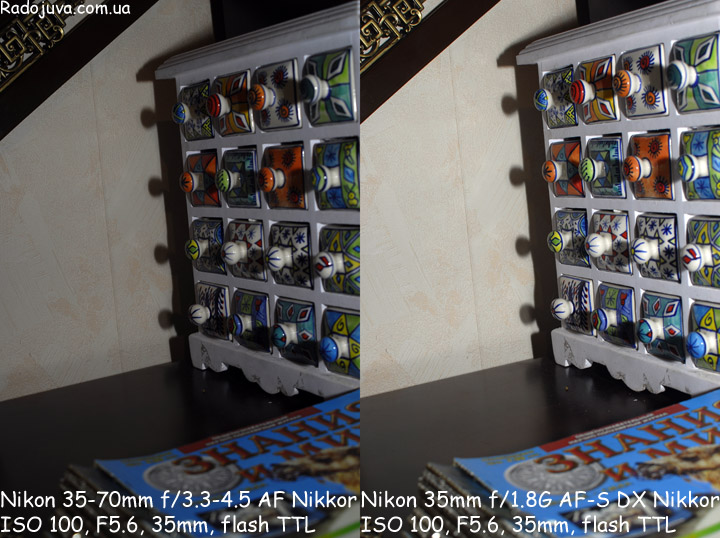
Difference in flash operation between Non-D, D lenses
There are a lot of AF lenses without “D” (NON-D), for example Nikon 70-210mm f / 4 AF or Nikon 35-70mm f / 3.3-4.5 AF Nikkor... If you do not plan to use AF lenses without “D” with flash, then you can safely buy them and shoot at your pleasure. And for good automatic flash work, you need to take AF with the letter D or AF-S / AF-P / AF-I lenses.
Attention: Also, transmitting the focusing distance to the camera allows you to use 3D Matrix Metering on some Nikon film cameras, which can significantly improve the quality of the exposure meter.
'E' type lenses
The most recent modern lenses in their name have the letter 'E', which means'Electromagnetic diaphragm '-'Electromagnetic diaphragm'. These lenses control the aperture (open and close the petals) using an electromagnetic mechanism built into the lens. As with 'G' type lenses, 'E' type lenses do not have an aperture ring. 'E' type lenses are also 'G' type lenses.
Don't be confused with the new 'E' marking, which indicates how the aperture works, and the old 'E (LENS SERIES E)' marking, which indicates budget manual lenses such as Nikon Lens Series E 50mm 1: 1.8.
The exact list of digital cameras that support working with 'E'-type lenses:
Nikon D3, D3s, D3x, D4, D4s, D5, D6, Df, D600, D610, D700, D750, D780, D800, D800E, D810, D810a, D850, D300, D300s, D500, D7000, D7100, D7200, D7500, D5000, D5100, D5200, D5300, D5500, D5600, D3100, D3200, D3300, D3400, D3500
+ Nikon z5, Nikon z6, Nikon z6 ii, Nikon z7, Nikon z7 ii, Nikon z9, Nikon Z fc, Nikon z50 with Nikon FTZ / Nikon FTZ II adapter.
+ Nikon 1 J1, J2, J3, J4, J5, S1, S2, V1, V2, V3, AW 1 with Nikon FT-1 adapter
The exact list of cameras that do not support working with 'E'-type lenses:
Nikon D1, D1h, D1x, D2x, D2h, D2xs, D2hs, D40, D40x, D50, D60, D70, D70s, D80, D90, D100, D200, D3000
+ Fujifilm FinePix S1 Pro, S2 Pro, S3 Pro, S3 Pro UVIR, S5 Pro, IS Pro
'E' type lenses on the cameras in this list will always shoot at full aperture. Other features of the work are possible.
Complete list of all Nikon 'E' lenses:
- E:
- Nikon N AF-S Nikkor 28mm 1: 1.4E ED
- Nikon N AF-S Nikkor 105mm 1: 1.4E ED
- Nikon N AF-S Nikkor 300mm 1: 4E PF ED VR
- Nikon N AF-S Nikkor 400mm 1: 2.8E ED FL VR
- Nikon N AF-S Nikkor 500mm 1: 5.6E ED PF VR
- Nikon N AF-S Nikkor 500mm 1: 4E ED FL VR
- Nikon N AF-S Nikkor 600mm 1: 4E ED FL VR
- Nikon N AF-S Nikkor 800mm 1: 5.6E ED FL VR
- Nikon N AF-S Nikkor 8-15mm 1: 3.5-4.5E ED Fisheye
- Nikon N AF-S Nikkor 16-80mm 1: 2.8-4E ED VR DX
- Nikon N AF-S Nikkor 24-70mm 1: 2.8E ED VR
- Nikon N AF-S Nikkor 70-200mm 1: 2.8E FL ED VR
- Nikon AF-P Nikkor 70-300mm 1:4.5-5.6E ED VR
- Nikon N AF-S Nikkor 120-300mm 1: 2.8E FL ED SR VR
- Nikon N AF-S Nikkor 180-400mm 1: 4E FL ED VR TC 1.4
- Nikon AF-S Nikkor 200-500mm 1: 5.6E ED VR
- PC-E:
- Nikon N PC-E Nikkor 24mm 1: 3.5D ED
- Nikon N PC-E Nikkor 45mm 1: 2.8D ED Microphone
- Nikon N PC-E Nikkor 85mm 1: 2.8D Microphone
- PC, E:
- Nikon N PC Nikkor 19mm 1: 4E ED
- Z, E:
- All lenses Nikon Nikkor Z
- 1, E.
- All lenses Nikon Nikkor 1
You will find more useful information in this section. 'Nikon' E Lenses.
Old non-autofocus (manual) Nikon lenses
Nikon has a lot of old lenses that don't have an autofocus system. Such lenses require manual focus, as well as on younger Nikon cameras unavailable metering exposure. Some lenses are still available, for example, Nikon 50mm f / 1.2 AI-S Nikkor MF. Usually, old lenses are indicated by letters MF, AI, AI-S, PRE AI, NON AI. All of them say that the lens does not have autofocus and indicate the type of iris control.
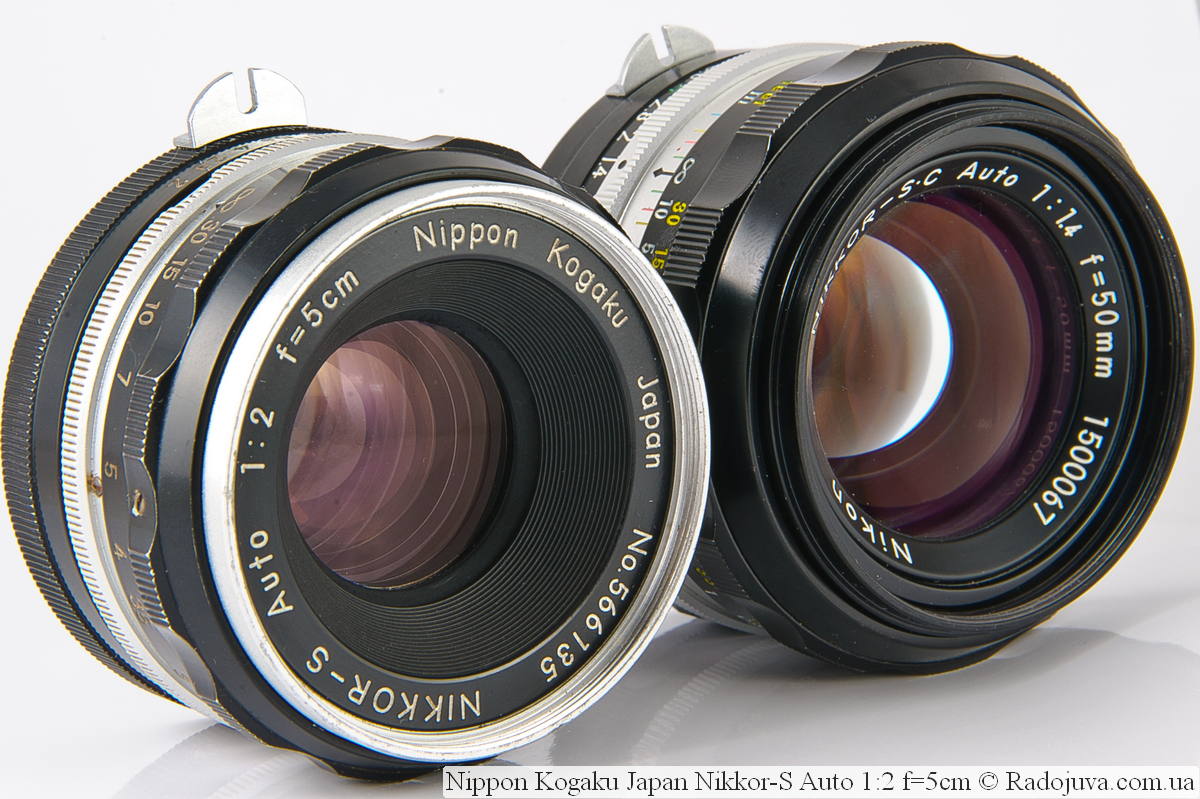
Old manual lenses Nippon Kogaku Japan Nikkor-S Auto 1: 2 f = 5cm и Nikon Nikkor-SC Auto 1: 1.4 f = 50mm
You can find more details about working with old lenses in my separate article “Work with old Nikon lenses".
An example of 'reading' lens designations:
The rest of the letters in the names of the lenses simply indicate the presence of some additional features. Consider the long name of the lens Nikon DX AF-S Nikkor 18-200mm 1: 3.5-5.6GII ED SWM VR IF Aspherical

Front dashboard with title Nikon DX AF-S Nikkor 18-200mm 1: 3.5-5.6GII ED SWM VR IF Aspherical

Back information panel Nikon DX AF-S Nikkor 18-200mm 1: 3.5-5.6GII ED SWM VR IF Aspherical
- Nikon - Nikon lens.
- DX - The lens is designed for DX cameras, on FX cameras it will give strong vignetting.
- AF S - the lens has a built-in focusing motor and it will be possible to focus automatically on any Nikon DSLR camera.
- Nikkor - almost all lenses from Nikon are called 'Nikkor' (Almost all).
- 18-200 mm Is a limit indicator focal length lens. 18 mm is the widest angle, 200 mm is the narrowest angle.
- 1: 3.5-5.6 Is an indicator of the maximum relative aperture of the lens. Maximum aperture of f / 3.5 is available at 18mm focal length, at 200mm only f / 5.6 is available. That is, it indicates that the zoom changes aperture the lens.
- G - you can control the aperture only from the camera. The diaphragm ring is missing.
- II - (near the letter G) - designation of the second lens modification.
- ED - Extra-low Dispersion Glass speaks of what is used in the lens special low dispersion glass, which allows you to get a better picture
- SWM - Silent Wbird Motor - quiet wave (ultrasonic) focus motor. Indication of the type of focus motor.
- VR - Vibration Reduction - a stabilizer that allows you to use longer excerpts for shooting without grease.
- IF - Internal Focusing - lens with internal focusing, when focusing, the front lens does not move. Important when using filters.
- aspherical - the lens uses special aspherical ASP, to improve the image.
- Ø72 - diameter of the front light filter
- Made in thailand - country of origin, made in Thailand.
Similarly, just by the name of any lens can draw a lot of useful information. You will find recommendations for choosing a camera and lenses here.
Comments on this post do not require registration. Anyone can leave a comment. Many different photographic equipment can be found on AliExpress.
Я constantly updating and supplementing this article. The article was last edited on 11.07.2023/XNUMX/XNUMX (added information on Z FX / DX).
Material prepared Arkady Shapoval. Training/Consultations | Youtube | Facebook | Instagram | Twitter | Telegram

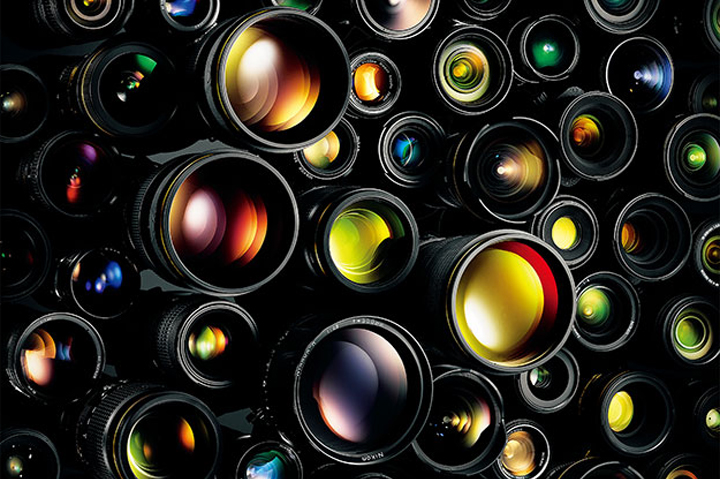
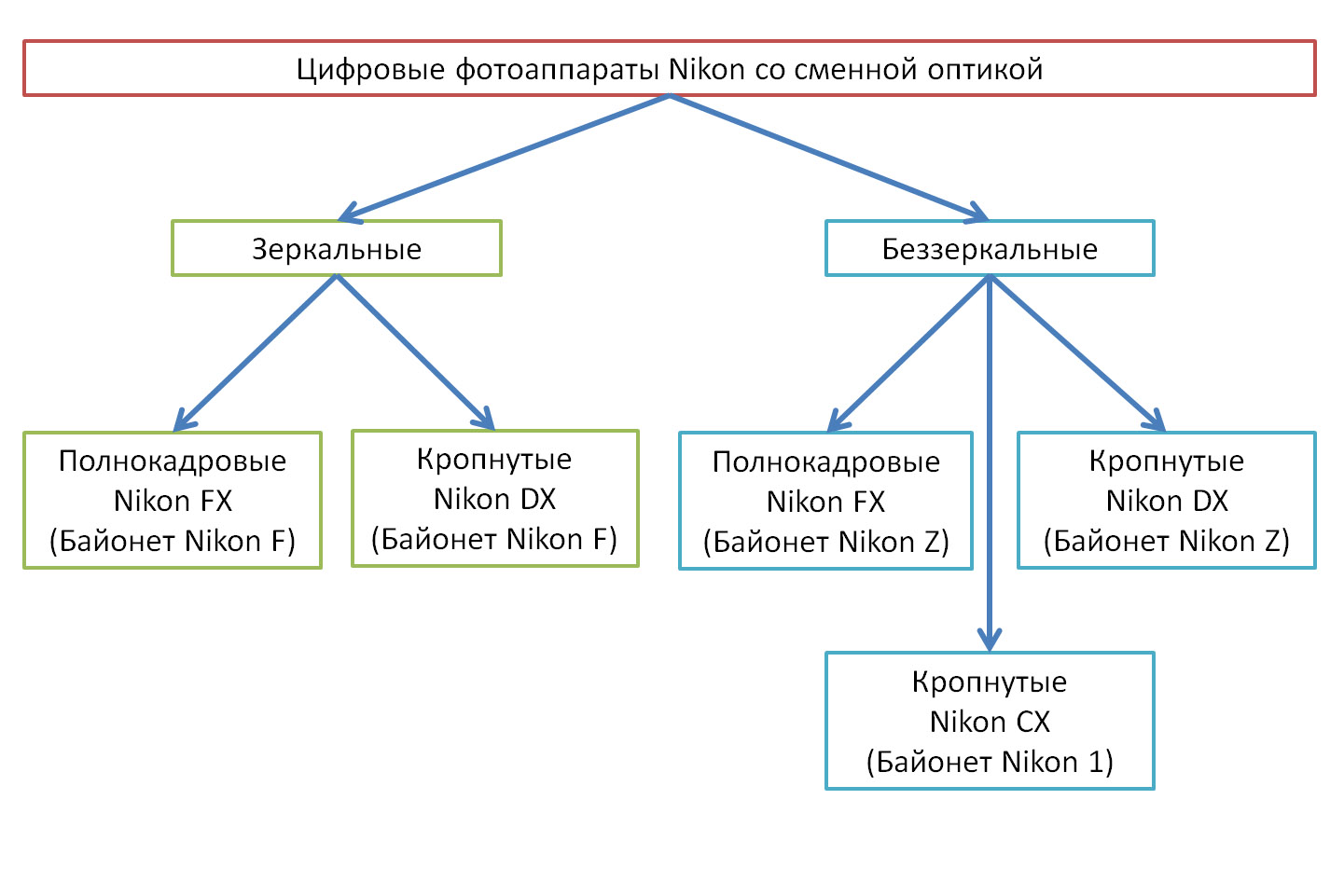
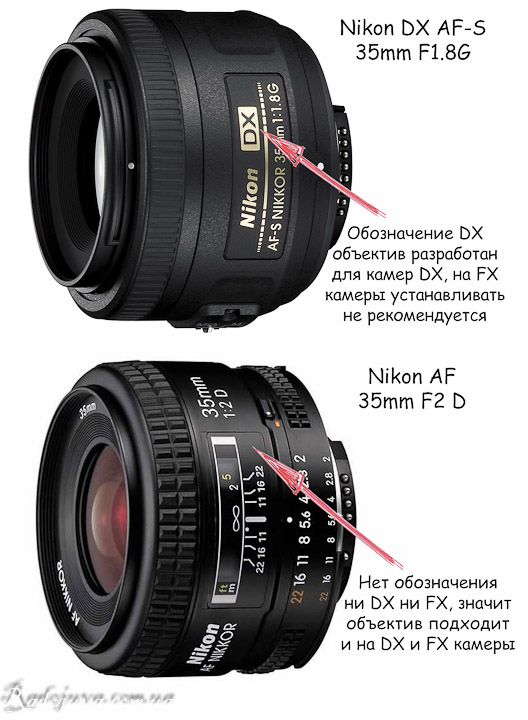


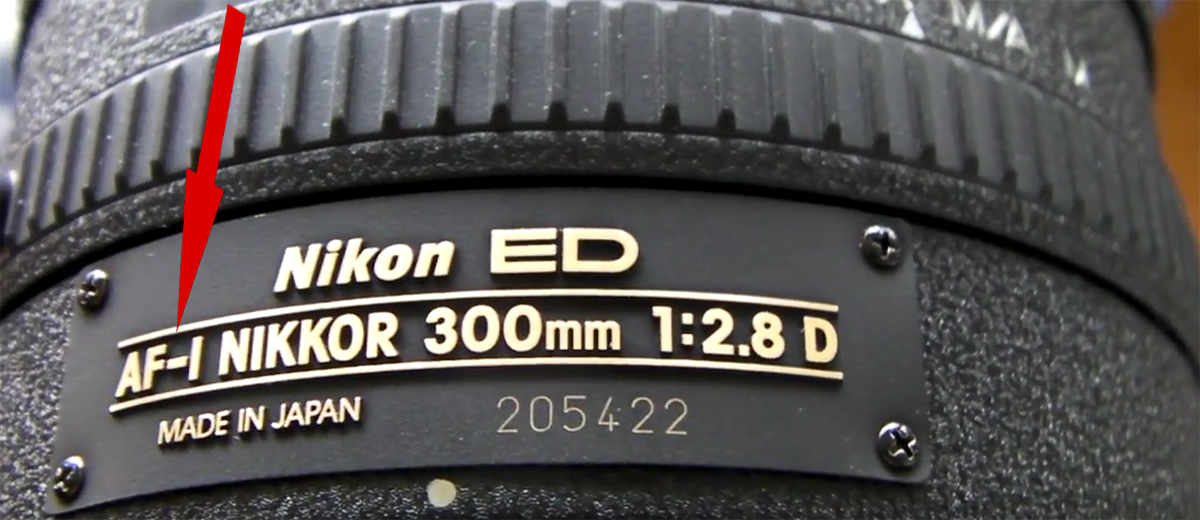
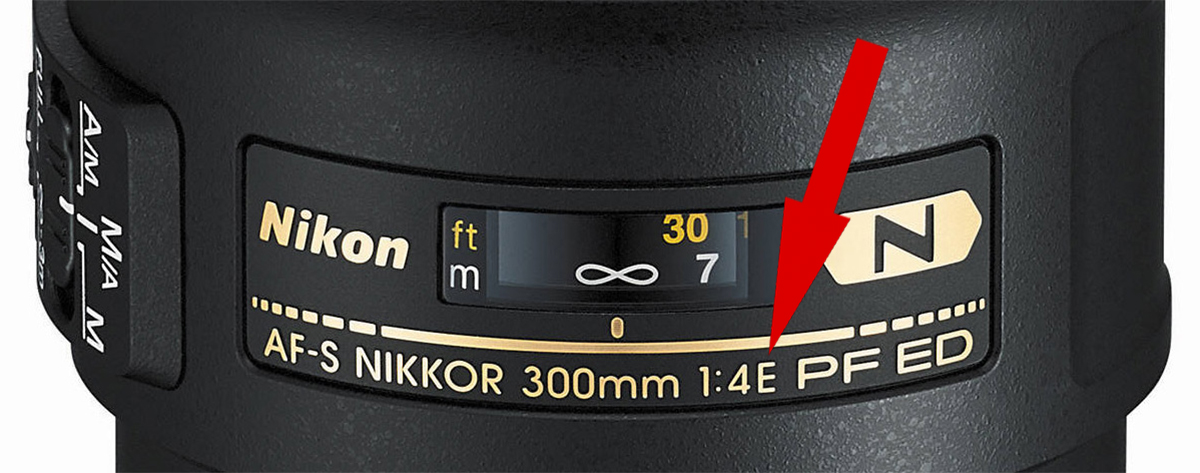

Arkady help with the choice of both the camera and the choice of lens. I am new to this business. I would like to take a good FA and even more so the lens. I already understood a little about lenses. For different shooting different models. Is there anything universal. They say it’s better to buy a cheaper carcass and a more expensive lens. I’m not going to shoot distant objects. And neither would like to change the carcass in a year or two. Thank you in advance. Evgeny.
My article will help with this - https://radojuva.com.ua/2013/01/what-camera-nikon-shoud-i-buy/
Hello Arkady!
Thank you so much for your work! Your project really helped me understand the avalanches of information on the Internet! Now I know exactly what to buy, and the tirades of sales consultants are not scary to me! ;)
Your opinion about the Sigma 17-50 mm F2,8 EX DC OS HSM-Objektiv is very important. I read a lot on the forums about comparing this lens and the similar Tamron SP AF 17-50mm 2,8 Di II VC (which you also recommend purchasing). I am alarmed by some of the technical flaws of Tamron, although it is attracted by its price. Sigma at the same time for 170 USD. more expensive, but, it seems, has no wear and tear ... I do not have the opportunity to buy / order a lens in a store, I prefer the Internet. Therefore, I cannot verify the quality of a particular Tamron specimen.
Thanks again :)
Thank you, Arkady, for your work!
It seems to me that it will be useful to talk about two very important markings that are found on modern and VERY good Nikon lenses:
- The gold ring on Nikon lenses indicates that the lens belongs to the professional class.
- N (Nano-Crystal Coating) - nanocrystalline lens coating to reduce flare and glare from frontal light sources. It is used recently and only in professional lenses (with a "gold" ring around the front lens), as well as in macro lenses.
Arkady, if these additions seem interesting and significant to you, it may be useful to include them in the main text of the article. And of course, with your thoughts and comments.
Thank you for the addition, but it is here that the differences that cardinally affect the use of lenses are collected. About the gold ring, N, PC-E, etc. there will be an additional article.
I'm new, I want to ask for advice! I would like to have a maximum of two lenses; I have a Nikon D600 Sigma AF 24-70mm f / 2.8 IF EX DG HSM lens, but it does not cover all focal lengths, but I would like landscapes, nature, animals, and a balanced lens with respect to price and quality. My budget is not too big
Good afternoon, tell me please, the Quantaray AF 100-300mm f / 4.5-6.7 lens for Nikon D3100 is suitable?
Hello! The information is well served), in principle, I knew everything) BUT I have a D3100, that is, a camera without a screwdriver) I bought an AF 18-50mm Sigma lens) that is, without built-in autofocus) And it focuses automatically from me) I was shocked myself) because I took it for camera with automatic focus) then put it on for an experiment) Maybe I don't understand something or don't know ...
The article contains information on Nikon lenses, for lenses from other manufacturers, information is here - https://radojuva.com.ua/2012/03/different-lens-main/
What a fool! Thanks: D
not a fool, but smart
Thanks! Finally, all the points are placed above Y. Only then everything became clear to me.
There is also some kind of lever on the lens near the orange dot - it switches up and down. What is it for?
Did I understand correctly about D that this is important only for external flashes in a shoe, a built-in D lens or not a D lens?
This applies to all flashes, including built-in.
Thank you very much, enlightened the dark!
Tell me Nikon 35mmf1,8GAF-SDX AND NIKON 50MM SAME. WHICH BETTER YOU WILL ADVISE THE NIKON D3100 CAMERA I FOLLOW. AND IF WITH 50MM F1 / 8D ON THIS CAMERA, HOW WILL IT BE? THANKS IN ADVANCE.
Many thanks to the author for the concise but very useful information on the issue of systematization and expansion of practical knowledge in the application of the objectives of their characteristics in their possible duplication, with examples and results .... especially useful for newbies in photography …… ..
Hello, advise me to Nikon D600, I can’t figure out all the settings for the norms, but I don’t want to focus automatically, only you can choose one point out of 39, what could be wrong ??
Hello, tell me on the D3100 Nikon 85mm 1: 1.8G AF-S Nikkor lens is suitable?
Yes, it does.
Oh mommy ... .. so much information, my head is spinning.)) The third day I read your site ... it's impossible to come off. The truth is that something comes to me immediately, something only after reading additional information from the following topics.)) Before us women, understanding does not immediately come))) I am a beginner in this difficult business. Recently completed photography courses (for beginners). I asked so many additional questions, and so I really could not get an intelligible answer. How to press what, and why that button, and why this one? And why should it be done like this and not like that? You feel like some kind of idiot, even though you paid money for the right to ask stupid questions. The author did not just lay out his knowledge or put it on the shelves, but in my understanding chewed it and put it in his mouth. For now, I am closing all my questions that interested me in the technical part. Arkady, thank you so much for such an incredible job, for your work !!! I read your post about the contribution to the development of the site, about what you want to buy ... I will definitely gladly thank you at the first opportunity for the knowledge I received from you! Thank you very much!
Hello, please tell the teapot, I read your article 5 times, but I still don't understand (sorry - I'm a blonde))) ... I have a Nikon 5100 with a whale lens 18-55, I want a little more aperture, and finances don't allow me to roam. I am torn between 50mm f / 1.8D AF and 50mm f / 1.8G AF-S Nikkors (they have a significant price difference for me). As far as I understand they are both compatible with 5100, but autofocus will not work with 50mm f / 1.8D AF, i.e. if I work with it manually, will there be no problems? And if the only difference is in autofocus - is it worth the extra charge? Or I'm wrong? Or should you even consider the 35mm f / 1.8G AF-S DX Nikkor?
It is quite difficult to focus in manual mode with a fifty-dollar 1.8D, especially out of habit, I know what I am talking about, I have it, although I have a “screwdriver” camera, that is, autofocus works with it. If you really want a fix, then look at the 35 / 1.8 AFS, or better, throw out the whale and take it as a staff 18-70 AFS
Hello, Arkady.
Thank you for your site.
My question is: Does Nikon have an analogue of “L” from “Canon” (dust-, moisture-proof)? Their labeling?
Please, help, I bought a 50 mm 1.8 lens, fotik d3000, in mode M everything is blurry and you can’t take a normal picture (in which mode is it better to take pictures of people? :(
Why do you need mode M? Turn on mode A (aperture priority, set the aperture value to a wheel, well, let's say 3,2 .. the rest of the camera will do it for you .. Yes, I forgot, when shooting portraits, people, in your opinion, focus on the eyes! Like everything ..
Arkady, hello. please tell me, I have Nikkor 18-105 everything suits except the zoom.
What is your lens: Sigma AF 18-250mm f / 3.5-6.3 DC OS HSM Macro Nikon F, from the point of view of working with Nikon D3100 - autofocus and stabilization, the picture quality seems to be quite good. I am an amateur with a lot of experience.
Respectfully Lysak.
please tell me the average telephoto for shooting with the D 5200 at a remote distance in a club concert (lighting in the hall is not so hot). I have a simple whale 18-55 (((
Arkady, thank you! You are just a storehouse of invaluable information!
Hello.
Does the AF-S NIKKOR 5100-70mm f / 200G ED VR II fit on the D2.8?
Yes, it does.
Thanks for the reply.
Just searching on the Internet, it’s not described exactly where to use it together (maybe I just didn’t find it, though I searched persistently) the D5100 and the AF-S NIKKOR 70-200mm f / 2.8G ED VR II lens.
Hello!
I want to buy a d700.
But I don’t know which is better
18-105vr DK55-300
Thanks in advance.
"Older non-autofocus (manual) Nikon lenses"
The author is a hose ... It’s a song that needs to be used if it’s with some minds and on some cameras it’s going to be frozen, with the rank of old people who have activated a certain number of diaphragms in front of the camera ... But it’s a bit of a furry camera that’s prettier. ask the maximum diaphragm for old people to sing for me ...
Ty kid, vivchay matchastinu and do not write to all sorts of garbage, more її teapots sprymayut seriously ...
You simply are not attentive and have not read to the place where links are given to detailed descriptions of camera compatibility, exposure measurements and other useful information. In particular, compatibility with PRE-Ai is described https://radojuva.com.ua/2012/06/nikon-ai-s-old-lens-about/and exposure metering is spread out on the shelves here https://radojuva.com.ua/2011/04/optika-na-nikon/#how-mount. Therefore, your words are considered an insult, and the e-mail has been added to the black list :)
Do not insult Arkady, I’ve studied the materiel myself!
Good day Arkady, please tell me. I would like to buy a lens ANISUMA 21mm 3.8 bayonet Nikon what do you say for this squabble for the wound thank you
I have never encountered such a thing.
Arkady, your opinion lens: Sigma AF 18-250mm f / 3.5-6.3 DC OS HSM Macro Nikon F or Nikon 18-200mm f / 3.5-5.6G IF-ED AF-S VR II DX Zoom-Nikkor which one to choose? Sigma is more interesting, but there is doubt. Tell me.